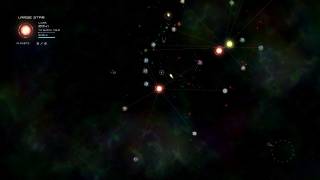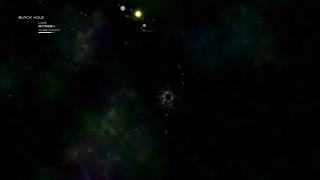Overview
 Float across the universe.
Float across the universe.Solar 2 is an "open world" space sandbox developed by Murudai. Players begin as an asteroid and work their way up the food chain of other space bodies by consuming smaller entities. Eventually, players can become a planet or a system of planets capable of supporting intelligent life. These life forms build fleets of ships that may attack enemy fleets. The player, however, has no control over these ships. Aside from growing and combating others, players may take missions from a mysterious deity. If the player completes enough missions, they unlock a surprise.
According to Murudai, Solar merely served as a prototype for ideas that would ultimately make Solar 2.
Player Forms
Solar 2 may be described in stages of evolution as the player grows from tiny asteroid to mighty black hole. As the player assumes better forms, he can recall basic forms or save the current state of his system for later use.
Asteroid
The player starts as an asteroid, which grows by colliding with smaller asteroids, growing in size and eventually reaching the status of small planet.
Small planet
As a small planet, the player can no longer collide with smaller bodies to grow. Small planets must instead coax asteroids to orbit them after which the orbiting satellites may be safely absorbed.
Life planet
After gaining enough mass to sustain life, the player's planet begins to show signs of evolution. Once evolution is complete, the planet's lifeforms will create shields, ships, and turrets to protect the planet. However, the player has no control over the planet's weaponry. Ships will attack almost anything: other planets, asteroids, and hostile ships. As a planet's ships and other defenses rack up kills the planet gains experience; as the planet levels up, its ships and turrets will grow in number and power.
Star
Devouring more asteroids will eventually transform a planet into a small star. Stars cannot have life and can no longer have asteroids orbit them; instead, they approach other planets and coerce them into orbit. As the star gains mass it progresses from small to medium, large, and neutron star, with each progressive level allowing the player more orbiting bodies. If the player helps the revolving planets to consume enough asteroids they can eventually follow the same progression as the player, developing life and even becoming stars themselves to form a multi-star system. Orbiting planets can also be absorbed to generate more mass for the player.
Black hole
 Bear witness to the end of all things.
Bear witness to the end of all things.After a neutron star absorbs enough planets, it will become a black hole. Black holes can only be destroyed by larger black holes, so the player must attempt to consume everything around him while avoiding these larger entities. Once a black hole reaches critical mass, it will cause the Big Crunch, absorbing every atom in the universe. The Big Bang then occurs again and the player resumes life as another asteroid.
Missions
During the normal progression of the game, the player may encounter other systems with life or nomads (hostile ships not in allegiance to any planet). They player may take on any of these rivals, either through collisions or by attacking with the ships on his systems. However, the objectives of the game are tied to various missions in the game. The objectives of each mission can range from stealing planets from other systems to traversing from one location to another without collisions.
Story missions are located at various locations in the game univers; if the HUD is visible, the locations of available missions are indicated by arrows around the player. Each level of progression--asteroid, planet, star--has its own unique set of story missions to take on. At any point the progress in any story mission branch can be erased to complete the missions again (for Steam Achievements, etc.).
Challenge missions are accessed from the game's main menu, Their objectives are scored, with point totals ranked from easy to hard objectives.
PC System Requirements
- OS: Windows XP SP2 or greater
- Processor: 1.5 GHz
- Memory: 512 MB RAM
- Hard Disk Space: 50 MB
- Video Card: 128 MB Graphics Card that supports Shader Model 2.0
- DirectX®: 9.0c
- Additional: Microsoft Xbox 360 Controller support
Log in to comment